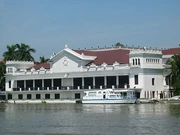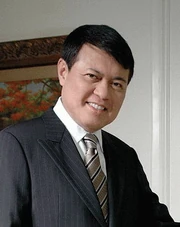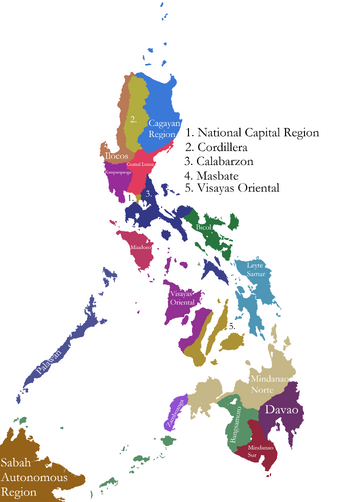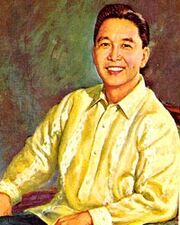The Republic Of The Philippines[]
The Republic of the Philippines is a democratic state in Southeast Asia, one of the few that survived Doomsday. Manuel Villar is the sitting President as of 2012. As of today, it is officially known as the Fourth Philippine Republic.
| |||||
| Capital | Manila-NCR | ||||
| Largest city | Manila (NCR) | ||||
| Other cities | Vigan, New Baguio, Cebu City, Zamboanga, Davao. | ||||
| Language official |
English, Filipino | ||||
| others | Bisayan (Cebuano), Ilocano, Hiligaynon, Waray, ,Chavacano, Kampampangan, Bicolano, Tausug, Spanish, Chinese, Arabic, Malay | ||||
| Religion | Roman Catholicism, Protestantism, Islam, Native Religons | ||||
| Ethnic Groups main |
Filipino (collective) | ||||
| others | Chinese, Tausug, Moro, American | ||||
| Government | Unitary Presidential Republic | ||||
| President | Panfilo Lacson | ||||
| Established | June 12, 1898 | ||||
| Independence | from United States of America | ||||
| declared | July 4, 1946 | ||||
| Currency | Philippine Peso | ||||
Page undergoing massive renovation!
History[]
Doomsday[]
The Philippines was a "minor" blip, owing to the country's alliance with an old colonizer, the United States. The targets (all on the island of Luzon) were the following:
- Clark Air Base, Pampanga Province - RZ 01
- Subic Naval Base, Zambales Province - RZ 02

Ferdinand Marcos
- Baguio City/Camp John Hay, Benguet Province - RZ 03
These locations, as well as the surrounding countryside, were later known as Restricted Zones or RZs; towns and cities such as Olongapo, Angeles City, San Fernando (both in Pampanga), and Baguio were destroyed along with the targeted bases. The United States had not alerted the Philippines until nuclear weapons had entered Philippine Airspace, but by then it was too late. Around 300,000 people were killed during the nuking of Baguio, Angeles and Olongapo. A further 350,000 were injured or were evacuated.
Indefinite Emergency (1983-1987)[]
The immediate days following Doomsday plunged the country into crisis. Emergency plans were quickly initiated by the National Disaster Coordinating Council (NDCC), prompting the evacuation of much of Pampanga, Western Bulacan, Southern Zambales, Bataan, and Tarlac to stations across Luzon; the operation took place over several weeks. President Ferdinand Marcos, still residing in the Malcañang Palace, declared Martial Law - as he did in 1972 - once more. Military forces were dispatched across the archipelago, quelling riots and overseeing rations. Government institutions were dispersed out of Manila into different provinces. By April 1984, the country was in lockdown, with government operations remaining in Manila "to ensure normality;" the Marcos family had relocated to Vigan, Ilocos Sur. With contact with the United States lost, the only things keeping Marcos and his cronies in power were the military loyalists and the desperate survival of their countrymen. Elsewhere, plans were made in establishing an "administrative citadel" in the Cordilleras: the future New Baguio.
The Chinese Refugee Crisis[]
As the nation began to stabilize in mid-1985, Coast Guard vessels reported several various sea craft - yachts, fishing boats, tugboats - off the coast of Ilocos Sur, Pangasinan, and Batanes Provinces. Upon inspection, these were found to contain refugees, mainly from China, totaling about 140,000. For the first time, Filipinos learned the extent of Doomsday (at least in East Asia); they were fairly convinced then that they were alone in the region. NDCC shelters quickly became overwhelmed with this influx, prompting Marcos to close down the country's maritime borders to prevent any further movements. Of the 140,000 Chinese refugees, only 30% were officially admitted by 1986. In a radio statement from the high-security New Baguio encampments, Marcos ordered all the remaining "illegal aliens" to be expelled by any means, "but as orderly as possible;" rumors circulated in the underground press of refugees being "escorted" at gunpoint. In later years, several political disappearances would be reported to have taken place around this time, including political activist Corazon "Cory" Aquino.
The Downfall of Marcos: "The Bloodless Coup of '87"[]
On 14 December 1986, classified documents were leaked into anti-Marcos channels, primarily military and activist elements; by former members of Marcos' inner circle. The papers and photos confirmed not only the "secret debriefing" of Benigno "Ninoy" Aquino's assassination - about a month before Doomsday - but also confirmation of the mass killings ordered by Marcos himself. Public reaction quickly exploded across much of the country, prompting the government to renew crackdowns on dissidents. A major incident was the Veritas Standoff in February 1987: several activists and Catholic clergymen held themselves inside the old Radio Veritas Building (Manila), broadcasting religious and pro-democracy messages until soldiers opened fire on the building; 14 casualties were the official tally. Amidst the renewed upheaval, Marcos' grip on the nation grew increasingly weaker, as various elements of society went in unison against him, including the Communist NPA (New People's Army) and Islamic MNLF (Moro National Liberation Front).
All this culminated in the "Bloodless Coup of '87." On 21 June 1987, a near-simultaneous uprising, led by former inner circle member Juan Ponce Enrile, took place nationwide as protesters overwhelmed government installations in peaceful marches of solidarity and faith. At 3:47 PM local time, rebellious soldiers under Enrile's direct command seized control of New Baguio, arresting Marcos and his remaining staff in a "Mandate of the people;" Marcos' "Bagong Lipunan" (New Society; Third Republic) came to an end with barely a shot fired. The (former) Presidential Family was placed under house arrest 22 km. east of Laoag City, Ilocos Norte. Marcos would die of heart failure in 1990.
The Founding of the Fourth Republic.[]
Juan Ponce Enrile placed the country under temporary military rule on 23 June 1987, to supervise the shift back to civilian democracy; the following months saw the "de-Marcosification" of the government. Institutions relocated after Doomsday was "settled down" into their present locations, with Malacañang Segundo - dubbed by the press as "The Mountain Palace" - based in New Baguio. A National Commission was assembled a few days later, comprising surviving congressmen, senators, and representatives from various groups. After three months of debates and arguments, the commission agreed to utilize a modified version of the 1935 Commonwealth Constitution, later known simply as the Revised Constitution.
On 8 November 1987, the first multiparty elections were held, with Salvador Laurel elected President of the Fourth Republic of Philippines on the 6 January the following year; the inauguration took place in Kawit, Cavite. The first years were marked with increaattention to the welfare and the first solid attempt to purge corruption. The Laurel years also marked the first efforts to reach out to both the NPA and MNLF. The end of the 1980s saw the beginning of the capital's re-population and reformation into Manila-NCR. It was also at this point that electricity had been mostly restored in urban areas.
1994 Reorganization[]
In the early 1990s, it became clear that the existing administrative system needed to be changed. The old provincial and district divisions became more inefficient to cope with domestic and political interests. Thus on 18 May 1993, a nationwide forum was held to decide on how to reform the system. Discourse soon went leaning toward economic and cultural lines; it was also suggested to grant greater independence to the Moros. The momentum put forward culminated in the passing of The 1994 Reorganization Act (Republic Act 1994): a thorough and comprehensive redrawing of the system above the provinces. The Act was also notable for granting Moro considerable autonomy.
It was also during this period that naval patrol boats began venturing out of national waters into the coast of Sabah. When contact was made with remnant Malaysian authorities in 1993, a plebiscite was held on whether to incorporate the region. On 3 August 1995, Sabah became an autonomous territory of the Philippines; though in practice control was limited to the region closest to the Moros. It is to be noted that a lot of provinces were removed, added, or had their borders redrawn after the reorganization. It is to be noted that the Malaysian Government had not relayed this information besides to Brunei until 1997.
[CONTACT WITH ANZC REMOVED FOR REALISM, PHILIPPINES NEVER GETS CUT OFF FROM COMMUNICATION, REWORK FOR THIS ERA WILL BE DONE SOONER OR LATER, FEEL FREE TO ADD THINGS HERE FROM 1994-1999]
"Pag-asa para sa Bagong Milenyo" (Hope for the New Millennium)[]
A national election was held in May 2000. Laurel was once more elected as president. Upon taking his third term, Laurel launched the program Pag-asa para sa Bagong Milenyo. This aimed at re-establishing economic and diplomatic relations of the Philippines with other nations that have survived Doomsday. Now with the destruction of the United States , the Philippines relied mainly on ANZC for support, and both countries signed a mutual pact on August 21, 2003. At this point most of rural Philippines had their electricity access restored, but with most of the oil supply being heavily damaged due to the destruction of global trade a lot of the energy comes from local, renewable energy. The largest wind turbine farm in Southeast Asia is currently in the Philippines, just north of Vigan. The farm provides 550GWh of energy annually.
The Modern Era[]
By 2005, Population Growth would recover to its pre-doomsday levels, with a noticeable change, due to exposure to much more radiation due to doomsday causing this new generation to have more immunity to cancer. This change was global, however, especially in places like Europe and Asia. 2007 would see the establishment of the Philippine National Electronics Company or "PNEC", the company being mostly nationally owned it would oversee the manufacturing and importing of Televisions and Wired Telephones, today the company has plans to start building computers for office use. Over the course of the 2010s, multiple insurrections in Southern Mindanao occurred in support of local radical Islamic groups. In 2017, a five-month siege of the Islamic-majority city of Marawi occurred. The siege involving MNLF forces and the Philippine Army ended with a decisive Philippine victory but with a portion of the city in ruin and hundreds of casualties. During the 2022 National Elections, Panfilo Lacson beat Bongbong Marcos, son of dictator Ferdinand Marcos, to become President by a small percentage. The elections sparked numerous rumors and controversies especially with some citizens remembering Marcos's fall from glory during the Bloodless Coup of '87. Although Bongbong Marcos did have a large number of supporters.
Conditions (As reported in the Philippine Yearbook 2020)[]
Population: 71.23 million (Estimated)
Religious Denomination:[]
Christian: 90%
- Roman Catholicism: 81%
- Protestantism including Evangelical churches: 7%
- Indigenous Churches: 2%
- Others: 1%
Muslim: 7%
Other faiths: 1%
Atheist: 1%
Five Most Populous Cities:[]
- Manila (NCR)
- Cebu City (Including cities like Lapu-Lapu City)
- Davao City
- Zamboanga City
- Puerto Princesa
Economy[]
GDP - 53.32 Billion (2022 USD)
Average GDP Per Capita - 1,493 (2022 USD)
Poverty Rate - 28%
Employment Rate (Adults) - 89%
Government and Politics[]

Malacañang Palace, Manila-NCR

Manny Villar, former president of the Philippines
The Philippines is a Presidential Republic, whose head of state is the president. According to the Revised Constitution, presidential Elections take place every six years, whereas three years for senatorial and congressional positions. The President can have only a maximum of three consecutive terms. Since Doomsday, there is increased representation from various ethnic and religious groups. Its official capital is Manila-NCR - locally referred to as "Metro Manila" - where the Senate, Korte Suprema, and Malacañang Palace are located. The events of Doomsday prompted the decentralization of major institutions, resulting in relocations to Cebu (notably Congress and the Opisina ng Ombudsman) and New Baguio (Department of Defense, Malacañang Segundo); most departments still maintain offices in Manila-NCR. The various territories have fair representation in both Congress and the Senate, though the autonomous elements have separate institutions. The current President is Panfilo Lacson, taking office in 2022.
Prominent Political Parties include:
- Partido Nacionalista
- Bagong Pagasa Party
- Liberal Party
- Chinese Conservative Party
- Philippine Communist Party
- Bangsamoro Regional Party
English and Tagalog are the national languages, although various languages (Cebuano, Ilocano, etc.) have official status as well at the territorial level. The main languages are frequently used throughout the country in almost equal proportion. Despite relative isolation, English proficiency remains high, particularly among the upper classes; a legacy of the Americans. More recent developments since 1997 have seen the development of a new lingua franca to replace Tagalog, known as "Filipino:" a synthesis of Tagalog, Cebuano, Kapampangan, Ilocano, and Chavacano (Spanish creole). Put forward by former president Salvador Laurel, it is part of the government's effort to promote nationalism and patriotism. It was, in effect, similar to the auxiliary language of Interlingua. The project is still under the scrutiny of the National Commission of Languages, the successor to the Komisyon ng Wikang Pambansa.
Although a democracy, a considerable influence still comes from dynastic political and business families, though not as dominant as during Marcos' day. To this day, corruption remains one of the main concerns of both government officials and NGOs, although efforts to curb it have been met with relative success over the years. Although there is a separation of Church and State in force, the Catholic ic Church remains potent, though relatively benevolent force in the national psyche.
Internationally, it has for the most part stayed out of foreign affairs, save for trade agreements. Filipinos have close relations with ANZC, East Timor , and Japan, although there is a degree of tension with Brunei following the annexation of Sabah. It is a founding member of the League of Nations.
Military[]
Philippine Armed Forces (1983:Doomsday)
Regions (Post-1994)[]

Regions Of The Philippines
Luzon[]
- Cagayan
- Ilocos
- Cordillera
- Central Luzon
- Kampampanga
- National Capital Region
- Calabarzon
- Bicol
- Mindoro
- Palawan
Visayas[]
- Visayas Occidental
- Visayas Oriental
- Leyte-Samar
Mindanao[]
- Zamboanga
- Bangsamoro Autonomous Region
- Mindanao Norte
- Davao
- Mindanao Sur
Sabah[]
- Sabah Autonomous Region (disputed boundary with Brunei)
Economy[]
The Philippine economy is primarily based on both agriculture and the mid-industry. Until the gradual reopening of global trade, trade was limited to the local level, or at best to outlying communities in Sabah; merchant trade with Taiwan started unofficially by 1996. Today, it maintains commercial relations with both the ANZC and SAC, with businessmen and workers establishing themselves on both sides. Given the extent of the Diaspora communities across the civilized world, the presence of "Returning Expats" and Overseas Professionals is growing into a potent trend.
Among the prominent local companies to survive Doomsday are Lopez and Associates, owners of the restored ABS-CBN media stations, and Ayala Enterprises, responsible in part for the reconstruction of Manila-NCR (based on old Makati plans and Burnham's 1900s designs). These corporations quickly took advantage of restored contact to establish a foothold in the international corporate scenes; Ayala now holds 20% of real estate properties in Taiwan.
Tourism in the Philippines has seen a small resurgence ever since the 2010s, the Philippines currently is the fourth most visited place in Southeast Asia and 34th in the world. However, numbers are nowhere near as close to the pre-doomsday numbers, especially with the destruction of the United States where most of their tourists come from. Some argue though that this is a good change, as places like Boracay were starting to see an overcrowding issue just before doomsday. Popular destinations include places like the recently mentioned Boracay as well as places like El Nido, Intramuros, The Banaue Rice Terraces, Mount Apo, and many, many churches like the Manila Cathedral or the Minor Basilica of the Holy Child of Cebu which is home to Magellan's cross.
The Philippines has been extracting oil from the South China Sea recently, off the coast of Palawan, In Pangasinan, Cebu, and Mindoro. However, extraction is limited due to how new the discoveries and extractions were, as of now the Philippines does not export any oil due to how valuable it is as a fuel source. President Villar stating that "Oil will be used as the main source of fuel for our ships and planes until alternatives could be found."
Energy-wise, the country is reliant on coal, hydroelectric, and geothermal plants for power. With much of its oil supply cut off by Doomsday, increased emphasis was placed on utilizing natural, renewable sources. Nuclear power meanwhile remains a taboo subject, with the Marcos-era Bataan plant still off limits. Vehicles have since been modified to run on coal and natural gas, as well as the controversial "hydro-engine," which runs on hydrogen and releases oxygen and water.
Transportation & Fishing[]
A lot of the country's transportation relies on cars or ships, and a lot of roads in the Philippines have not been damaged, currently, the longest highway in the Philippines is the Pan-Philippine Highway which spans from Luzon to Mindanao, it is to be noted however that most crossings use ferries to bring cars, this excludes the Leyte-Samar Bridge.
Most cars are powered by hydrogen and water via the previously mentioned hydro-engine. The country also has a large bus system which is mostly operated by the Balig Bus Company, which runs bus systems across the country, excluding Bangsamoro. The nation also has a small rail system, which runs through Manila, currently, all trains are run by the government and no expansions have been made, only maintenance and renovations of railway tracks and trains. Just like other modes of transport travelling and use of land vehicles have been made much cheaper since the resurgence in global trade in the 2010s.
Ships are widely used, ever since doomsday however, many have reverted to using coal and steam for powering ships, and some ships companies are experimenting with using wind for entirely powering their ships. A lot of ships however still use oil for fuel. The largest shipping company runs passe, which runs passenger and cargo operations across the Philippines. The largest and busiest port in the Philippines is the Port Of Manila, followed by the Cebu and Davao Ports. Operating of ships and tickets have been made much cheaper due to a resurgence in global trade (in spared regions), especially with oil which has less buyers due to doomsday.
Fishing is a large industry in the Philippines, accounting for 8.8% of the Philippine GDP. Around 560,000 people rely on fishing for their job in the Philippines, many popular fishing sites include Manila Bay and the Davao Gulf. The most common and popular fish is disputed, many fish like the Kitang, Milkfish, Sapsap, and others are all common.
Planes have seen a massive drop in use ever since doomsday, especially commercial ones. Despite the sparing of most of the Philippines airports saw a massive drop in use, currently, there are 2 airlines in the Philippines as of 2009 which are Philippine Airlines and Cebu Air (Known as Cebu Pacific OTL). Cebu Air just recently opened after the removal of the One Airline policy. Most of the former aircraft are either lying in empty apron spaces in airports which are only used for non-commercial purposes, resold, or scrapped. Since the 2010s however aircraft operations and tickets have been made much cheaper due to a resurgence in global trade (in spared regions), oil has been made cheaper due to less buyers due to doomsday. Cargo Airlines are non-existant in the Philippines and all operations are run by foreign airlines.
Fleet & Destinations of Cebu Air & Philippine Airlines (2023)[]
Philippine Airlines[]
- 2 A300B4's (Manila-Bangkok, Manila-Ho Chi Minh or Manila-Jakarta, Manila-Singapore)
- 4 Boeing 737-200's (Manila-Cebu, Manila-Davao, Manila-Puerto Princesa, Manila-Iloilo)
- 1 Boeing 747-200B (Manila-Canberra or Manila-Adelaide)
- 2 Fokker F-27s (+1 Being converted for passenger use after being transferred from the Philippine Air Force)
- 7 EM-210's (Other Domestic Routes)
Cebu Air[]
- 4 Boeing 737-200's (Manila-Cebu, Manila-Davao, Manila-Puerto Princesa, Manila-Iloilo)
- 3 Douglas DC-9's (Manila-Legazpi, Manila-Tacloban, Manila-Cagayan De Oro)
- 7 Douglas EM-210's (Other Domestic Routes)
- 0 Fokker F-27's (+2 Being converted for passenger use after being transferred from the Philippine Air Force) (Other Domestic Routes)
Do note that the EMBRAER 210 is a fictional aircraft based on a reproduced and more efficient DC-6.
Culture[]

Lupang Hinirang
A recording of the Philippine National Anthem for the Centennial Anniversary (1998)
Filipino culture is a blending of native, Chinese, Spanish, and American influences; in many aspects Hispanization is prominent. Although Urban society is more cosmopolitan and fast-paced, reflecting somewhat pre-Doomsday America, Rural life, particularly the "Christian lowland," is relatively conservative; though the "modern" is seeping through the "traditional." Both, representative of the predominant Christian/Catholic populace, are in contrast to the "Native Islamic" trappings of the Moros, and the indigenous tribes. In general, Filipinos value family, kahiyaan, and faith. The events of Doomsday prompted Filipinos to focus on community building, resulting in more fervent nationalism among otherwise disparate members of society.
While the Philippines has no official religion, Roman Catholicism is considered the de facto predominant faith, adhered to by many Filipinos. Due to this reputation, the country is unofficially known as the "Catholic Center" of East Asia, owing to its heritage with the Catholic Church. Its clergy and more represent the A represent the Asian faithful in the Vatican. Increasingly, however, there had been an increase in Protestant and Evangelical followers as well as (more controversially) the rising clout of the homegrown sect known as the Iglesia ni Cristo. The legitimization of atheist and Communist groups as well as the increasing acceptance of Muslims have also left their mark on modern Filipino society
Sports[]
Filipinos consider Basketball and Football as their prime sports. The country is home to several sports teams and clubs; some of which date back pre-Doomsday. The most popular sport, basketball is common, you can see many basketball courts scattered across many urban areas. You can also see a lot of people, from children to adults playing daily in many neighborhoods, from urban to rural.
Gallery[]
See also[]
UPDATES ONGOING
SEE ALSO - 2011 Philippine Presidential Election (1983: Doomsday) (MOSTLY EMPTY), List of Presidents of the Philippines (1983: Doomsday) (DOOMSDAY & POST-DOOMSDAY ONLY), Manny Villar (1983: Doomsday)
This page is adopted by altillidanlestat
| ||||||||||||||||||||||















